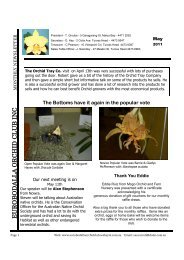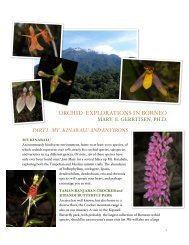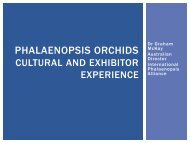Orchid Growing Substrates
Orchid Growing Substrates
Orchid Growing Substrates
Create successful ePaper yourself
Turn your PDF publications into a flip-book with our unique Google optimized e-Paper software.
Mosses<br />
Historically mosses were used for potting orchids for centuries. It is clear too that some early Chinese and<br />
Japanese grower’s manual, when speaking of moss, did not consider Sphagnum moss, but what we call ‘sheet<br />
moss’, or ‘wood moss’, which is the usual growing media of quite a few Paphiopedilum species. It is as well<br />
the usual growing media of quite a few epiphytic species. However, there are a nearly infinite number of<br />
mosses genus and species, some suitable, some not. Lance Birk, the noted Paphiopedilum grower, did design<br />
a mix using bark and sheet moss nearly 40 years ago. It is a very successful mix, partly because most sheet<br />
moss has a poor buffer capacity, and therefore will not remain acid for a long time. It is aerated, and moss can<br />
regrow in the pot. However if the moss dies, it will kill the plant by decomposition after a while, and<br />
depending on the temperature, the feeding and other elements it can become really sour suddenly. Xavier<br />
used successfully moss in the mix; however it has now been replaced. Irrational thinking’s can always come,<br />
and when using sheet moss and bark, the plants grow well, notwithstanding the decomposition of the<br />
potting mix, that can be pretty fast. The next question was to find out what the moss really brings to the<br />
plants, and, apart from some water retention, that can be easily reproduced with other materials, or adjusting<br />
the watering frequency, it provided, through its decomposition, organic compounds and micronutrients. The<br />
microflora harbored in the moss could have had its importance, but so far the effects can be reliably<br />
reproduced without the use of sheet moss anymore. Study the two aspects of a product, physical and<br />
chemical, that’s the key to find how to replace some ‘magic ingredients’.<br />
Sphagnum.<br />
- Sphagnum moss is probably one of the most popular compounds around the world. It has been used<br />
for a long time, since the early days of orchid culture. In the 19th century, live sphagnum moss was<br />
used mixed with osmunda fern roots. It is important to note that the sphagnum used was from<br />
Europe at that time, and alive. In the USA, sphagnum harvested locally was used too, with various<br />
successes. Many growers reported that some ‘colors’ and structure of sphagnum grew pristine plants,<br />
where some other ‘colors’ especially the red small headed types were strongly phytotoxic to the<br />
plants. Now, we know that there are many sphagnum species, and some can even colonize sodic<br />
marshes, pure water stream, forests, bogs and swamps. In Europe the harvesting has been strictly<br />
controlled and prohibited subsequently, as sphagnum became rarer. Anyway, with the tissue culture,<br />
and the massive productions starting in the 50’s of many hundreds of thousands of plants around the<br />
world, it was not feasible to harvest sphagnum in Europe and the USA to re-pot such plants.<br />
Sphagnum was used in Europe commercially until the mid-90’s as a local harvest in France and<br />
Germany, with some further supplies from Denmark. However, most European sphagnum moss<br />
would not last very long, and it was always preferred live. The attempts to use it dried were<br />
sometimes successful, sometimes not, and anyway it required a very low mineral salts content of the<br />
water not to decompose. Most moss from the Northern Hemisphere would not become a popular<br />
commercial success, because of problems of availability, lack of resources, especially renewable ones,<br />
and the fact that most of the easy to harvest sphagnum moss did not react well to many chemicals. As<br />
an example, the French Sphagnum moss would become gray and metallic smelling nearly overnight,<br />
killing the plants, after a single application of either a copper compound, or fosetyl-al fungicide, or<br />
even of some fertilizers containing urea.<br />
- First, there are some things to state about Sphagnum moss. A lot of misconceptions arise around<br />
‘sphagnum bogs’, and again ‘very low mineral content’ sphagnum moss. In fact, sphagnum moss<br />
tends to grow first in full sun for the commercially harvested varieties, with its ‘feet kept cold’. In New<br />
Zealand, it grows on apparently very old grey clay, with a junction that is wet, and the fibers are<br />
Xavier Garreau de Loubresse<br />
12
















